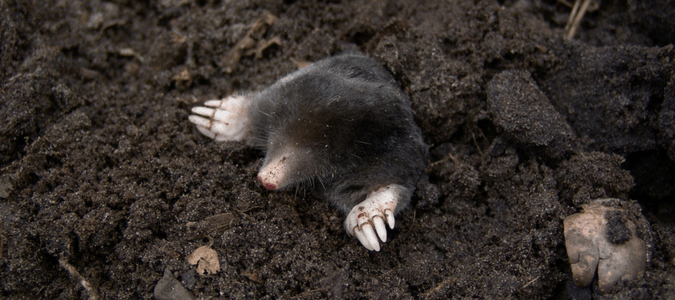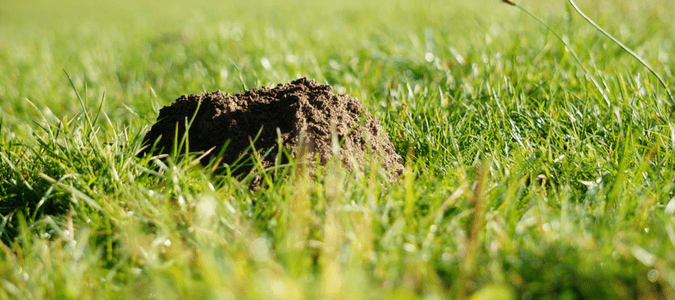Do you know the common mole characteristics and signs of a mole problem in your yard? Most homeowners believe that moles are nocturnal animals, which is not the case. However, it is still unlikely that you will see a mole in broad daylight because of their behaviors.
The easiest way to identify a mole problem is by the damage they create in your yard. Moles dig underground tunnels that run like a freeway system below your feet. Their runways can destroy plant and tree roots and damage your grass. Plus, the dirt mounds and molehills that they leave behind are unsightly.
A pest control expert can control your mole problem, whether you have a solitary mole in your yard or a whole family. Moles reproduce at a young age and can have several pups in one litter.
Are Moles Nocturnal?
Contrary to popular belief, moles are not nocturnal. However, they are most active during quiet hours to avoid humans and predators. They wait until they do not hear anything moving around outside their burrows to run through their tunnels, which means they can be most active at night and in the early morning hours.
Moles sleep in four-hour increments, and they spend most of their lives underground. Even though moles are not nocturnal, it is still rare to see them. Male moles surface in the spring to look for a mate, but a mole sighting is still rare.
Most of the time, you will know you have a mole problem because of their molehills and the damage they can do to your property. Molehills and tunnels can quickly become an eyesore in your yard.
Moles are expert diggers, and they can build their underground tunnels extremely fast. Their six-fingered paws with two thumbs are made for digging through tough dirt.
Mole activity can also cause damage to your garden. However, moles do not eat garden vegetables. What do moles eat? Since they are carnivores, moles feed mostly on earthworms and grubs. Sometimes having one mole on your property can benefit your garden because they keep grub worms away from your plants.
On the other hand, the damage that moles can cause outweigh any benefits. Mole tunnels can destroy your plant and tree roots and destroy your grass. Moles are extremely fast diggers, and it only takes one mole a few days to destroy a beautiful yard.
Plus, moles mate in the spring, which means that one mole can quickly turn into a whole family of moles, causing property damage. If you see a mole or a molehill on your property, contact a pest control expert to deal with the unwanted guest right away.
How to Prevent Moles From Coming Back
Moles usually only weigh eight ounces. However, despite their small size, they can cause significant damage to your lawn. One mole can dig around 18 feet in one hour.
The signs of a mole infestation include spotting raised ridges of dirt throughout your yard, dead and discolored grass and six-inch tall molehills shaped like volcanos. You may also notice loose or soft soil and more weeds growing than usual.
Contacting a pest control specialist is the first step to dealing with a mole problem. Once the mole population is gone, there are a few steps you can take to minimize the possibility of a mole making its underground home in your yard again.
How to Get Rid of Moles
First, taking away their food source will make moles dig their tunnels elsewhere. Moles feed on grubs, so you can use an insecticide to eliminate grubs in your yard.
Next, you can try creating an at-home mole repellent by mixing castor oil and dish soap together. Combine one part dish soap with three parts castor oil and then add the mixture into a gallon of water. Pour the repellent into the molehills, which are the entrances to their tunnels. There are also store-bought repellents that you can spread over your lawn.
Moles like moist shelters, so cutting back on excess watering can help deter them from your yard. Keeping your garden beds tidy and your grass short can also keep them out because they won’t have a thick cover.
Installing a sonic spike in your garden will also deter moles. The spike will send electronic pulses into the ground and create a chaotic environment for mole activity. Since moles have poor eyesight, they rely on their hearing to search for grubs, which is why they like to dig tunnels in quiet areas. Electronic pulses will prevent them from hearing their prey so they will search for a new, quieter home instead.
You can also create barriers to keep moles out of your yard. Natural barriers are flowers with strong smells, like Alliums, marigolds and daffodils. In your vegetable garden, the smell of garlic and shallots can also keep moles away.
Another barrier option is to install wire fencing that goes two to three feet underground. It should stick one foot out of the ground. Finally, you can dig a trench around your property and fill it with rocks or mesh wiring. Make sure the trench is at least two feet deep and six inches wide.
Some homeowners prefer to combine the last two methods and line their trenches with a wire fence. The more you make your yard an unfriendly place for moles, the less likely they are to return. Of course, the most efficient and effective way to get rid of moles in your yard is to contact a pest control specialist.
Do Moles Make Noise?
Moles live alone for most of their lives; however, when they are around other moles, they will communicate with noise. They use chirps, snorts, guttural noises and high-pitched squeals to communicate. Some mole species also wheeze.
These pests also make a shrill squeaking sound when they have a hostile encounter with humans or other animals.
Despite producing a variety of sounds, most homeowners won’t hear moles. It’s more common to see their damage, such as molehills, displaced dirt and injured plants, trees and grass.
If you do hear a mole in your yard or notice unusual lawn damage, call a pest control specialist to inspect the problem.
How Long Do Moles Live?
Unlike other burrowing creatures, moles can survive a long time underground with very little oxygen. However, the average lifespan of a mole rarely lasts beyond three years. In rare cases, some moles can live up to six years.
Moles mature extremely quickly. They mate once a year in the spring between February and April, and mole pregnancies last for six weeks. Female moles can give birth in their underground tunnels, and they have two to eight pups in each litter. Mole pups only stay with their mothers in their nests for four weeks before setting out on their own.
Once they leave their nests, moles search for their own place to build underground runways. They live solitary lives until springtime rolls around, and it is their turn to mate. When they are around ten months old, moles reach sexual maturity.
Since moles reproduce at a young age, a mole population can quickly become a problem for homeowners. Plus, their mating schedule aligns with spring planting time, which can thwart your garden plans.
If you suspect moles have taken up residence underneath your yard, contact a pest control specialist before the problem multiplies.
Keep Moles Off Your Property
Since moles live most of their lives underground, they can seem harmless. However, they can cause severe property damage, create unsightly molehills and spread diseases.
Moles are not nocturnal, but they are most active during quiet hours at night and in the early morning. As a homeowner, it’s rare to actually see a mole surface above ground, unless it is a male searching for a mate in the springtime.
While moles do make noises to communicate with each other, most of their chatter happens underground and out of hearing distance for homeowners. It’s more common to identify a mole problem by the damage they do to your yard.
There are several ways to prevent moles from taking up residence in your yard, including using repellents, digging trenches and creating barriers. However, before you utilize those methods, contact a pest specialist to control your mole problem first.
Moles reproduce quickly and at a young age, so it’s crucial that you act on your mole problem as soon as you see signs of their presence. They are not friendly creatures when they feel threatened, so utilize the help of a pest control expert to kick them out and keep them off your property.
ABC Can Control the Moles on Your Property
Once you realize you have moles in your yard, the best way to deal with them is by contacting a professional mole control serivce. ABC Home & Commercial Services can control your pest problem.



